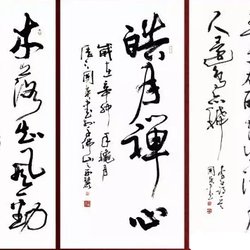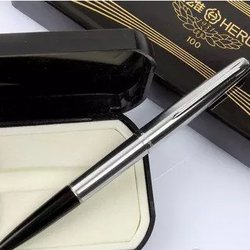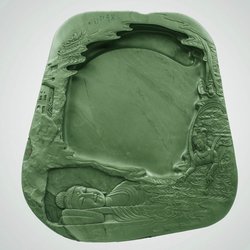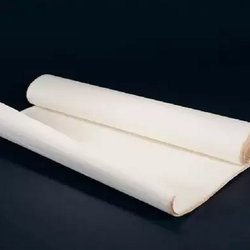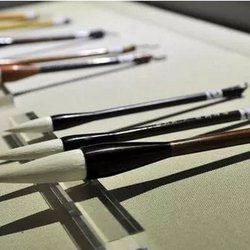1. What is the difference between raw Xuan and cooked Xuan, cotton material and pure leather?
Rice paper is divided into raw xuan and cooked xuan, and raw xuan is further divided into cotton material, which has a clean skin and is particularly clean.
Shengxuan is unprocessed, has strong water absorption and water-clearing properties, and is easy to produce rich ink rhyme changes. Use it to splash ink and accumulate ink, which can absorb water halo ink stamps and create rich and colorful artistic effects. It is often used in freehand landscapes. Although Shengxuan's paintings are full of ink interest, they are fixed as soon as he starts writing. The ink penetrates quickly and is difficult to master.
Ripe xuan is coated with alum during processing, so the paper is harder than raw xuan and has weaker water absorption capacity, so the ink and color will not spread when used. Therefore, Shuxuan's characteristics make it suitable for painting meticulous paintings rather than freehand ink paintings. The disadvantage is that "alum leakage" or brittleness may occur if stored for a long time. Ripe xuan can be reprocessed. Coral, mica paper, cold gold, wine gold, wax gold flower rib, pink tiger skin, etc. are all types of paper that are reprocessed from ripe xuan. Half-cooked xuan is also processed from raw xuan, and its water-absorbing ability is somewhere between the former two.
Generally speaking, cotton material refers to paper whose raw material sandalwood content is about 40%, which is thinner and lighter; pure paper refers to paper whose raw material content of sandalwood reaches more than 60%; and special paper's raw material content of sandalwood reaches more than 80%. . The heavier the leather content, the better the paper can withstand tension and the better the quality. The corresponding effect is: paper with a higher proportion of sandalwood can better reflect rich ink levels and better moistening effect, and can withstand the pressure of writing. Rub it repeatedly without breaking the paper surface.
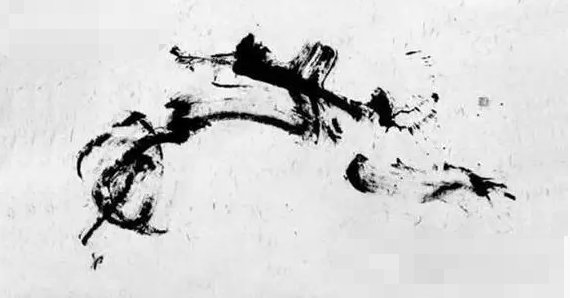
What is the difference between raw and cooked propaganda?
1: Raw rice paper has good water absorption properties and is used for calligraphy and freehand painting! Ripe rice paper has poor water absorption, so it is often used for painting traditional Chinese paintings!
2: Raw Xuan is slightly softer than cooked Xuan
3: Raw Xuan has stronger water absorption than cooked Xuan
4: Raw Xuan is made of cotton, clean leather, special leather series Xuan, and has not been processed, while cooked Xuan is just the opposite.
5: Raw Xuan is suitable for calligraphy, calligraphy and painting, traditional Chinese painting, freehand brushwork, landscapes, figures, flowers and birds; while Mature Xuan is suitable for fine brushwork
6: Half-cooked rice paper is suitable for writing official script or regular script.
Familiar propaganda category:
Mud-gold paper and mud-silver paper (the main production area is Jingxian County, Anhui Province. As long as it is a rice paper craft factory, it can produce mud-gold paper with various colors. The quality is also uneven. The top-grade mud-gold paper has smooth paper and is easy to be inked without being gray. It is matched with burnt. Ink, if dotted like lacquer, it is top grade)
Golden latent paper (mainly fine-grained flowers, birds, landscapes and figures in small regular script, currently not produced in Jingxian County, the supply is produced in Guangdong and imported from Japan, but the price difference between the two is almost double, and of course the quality is also significantly different)
Aluminum dispersion (Customized alum dispersion is better, strong tensile strength, repeated rendering without fluffing is the top grade, there is no representative brand for the time being, the quality of Red Star alum dispersion is more stable)
Half-cooked rice paper:
Tofu Jian (making tofu water)
Boiled Hammer Xuan/Water Textured Xuan/Tiger Skin Paper/Betel Nut Paper/(Alum hydrocolloid processing)
Pollen paper/pastel paper/(screen printing)
Health promotion category:
Cotton material, clean leather, special leather (Red Star rice paper)
Fiber fiber (hemp fiber, long fiber, mulberry bark, etc.)
How to identify the quality of cotton rice paper?
1: Lift it up and look at the light to see if the thickness of the paper is evenly distributed.
2: Use a brush to dip some water drops on it and check the degree of smearing. Usually it shouldn’t be too big. The smudged edges will be almost the same size.
3: There will be no hard creases when rolled up gently.
4: Look at the manufacturer of rice paper. Generally, Red Star rice paper will not have quality problems.
5: The cotton nature of the paper, good rice paper will have a cloth feel!
2. Which font and rice paper are best?
My own feeling is:
1. Official script—half-cooked rice paper is the best for writing official script. Because the cooked xuan is too slow to write, and the speed of raw xuan is slightly slower, it is difficult to express the characteristics of official script silkworm head and swallow tail.
2. Regular script - To write smaller characters in regular script, generally use Shu Xuan or Ban Shu Xuan. Which one to use depends on what suits you personally. Everyone's preferences are different. Moreover, the quality of rice paper produced in different places also varies. You can try different cooked xuan, or choose raw xuan according to your level and character size.
3. Running Script ----- Running Script is of course also written in Shengxuan. A little more water in the ink can make the writing smooth. For small characters, use cooked Xuan or half-cooked. For large characters, use Tejing or Jingpi.
4. Seal script - it is better to use Shengxuan for seal script. The structure of seal script is tight at the top and loose at the bottom. The structure is rectangular. The thickness of the lines should be basically the same. The strokes of seal script are only horizontal, vertical and round, without waves or dots. , fold; horizontally and vertically, the lines must be drawn out with strength and flexibility. When writing, the starting point of the pen should be round, and the closing point of the pen should be both hidden and out. Shengxuan is highly absorbent, and it is easy to write with a pen that hides the head and tail. Therefore, the paper used to write seal script is generally better for raw xuan. Mature The pen and strokes are easy to appear on rice paper and appear dry.
Some of the above opinions are not necessarily completely correct. Apart from some well-known common sense, most of them are just some of my personal experience in writing calligraphy for many years. I hope my friends can give me some advice!

